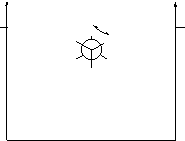

 1
2
3
4
5
6
7
8
9
10
11
12
13
14
15
16
17
18
19
20
21
22
23
24
25
26
1
2
3
4
5
6
7
8
9
10
11
12
13
14
15
16
17
18
19
20
21
22
23
24
25
26


•![]() Observed: H’-C-C-H”
Observed: H’-C-C-H”
•![]() typically not observed: H’-C-O-H” and H’-C-N-H” (fast proton exchange)
typically not observed: H’-C-O-H” and H’-C-N-H” (fast proton exchange)
The splitting pattern is a related to the number of equivalent H-atoms at the
neigbouring atom.
•
•
•
•
•
•
•
•
1 H atom as neighbor dublet (1:1) (e.g. -CH-CH-)
2 H atoms as neighbors triplet (1:2:1) (e.g. -CH-CH2![]() -)
-)
3 H atoms as neigbors quartet (1:3:3:1) (e.g. -CH –CH3)
4 H atoms as neigbors quintet (1:4:6:4:1) (e.g. -CH2-CH-CH2-)
5 H atoms as neigbors sextet
6 H atoms as neigbors septet (e.g. CH3-CH-CH3)
.... ...
n H atoms as neighbors n+1 lines
1 1
1 2 1
1 3 3 1
1 4 6 4 1
1 5 10 10 5 1
for the resonance.Rules for coupling
![]() 3J couplings the magnitude of the coupling constant depends
3J couplings the magnitude of the coupling constant depends
angle:

![]() o
o